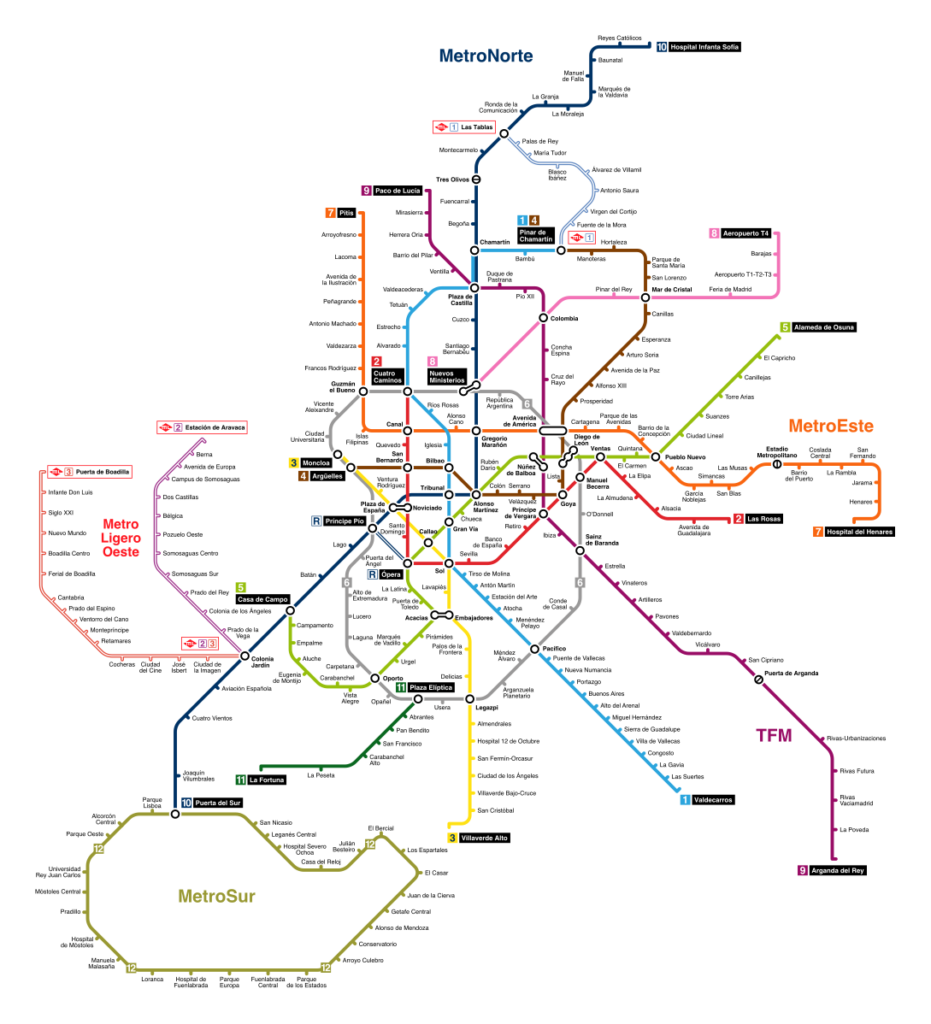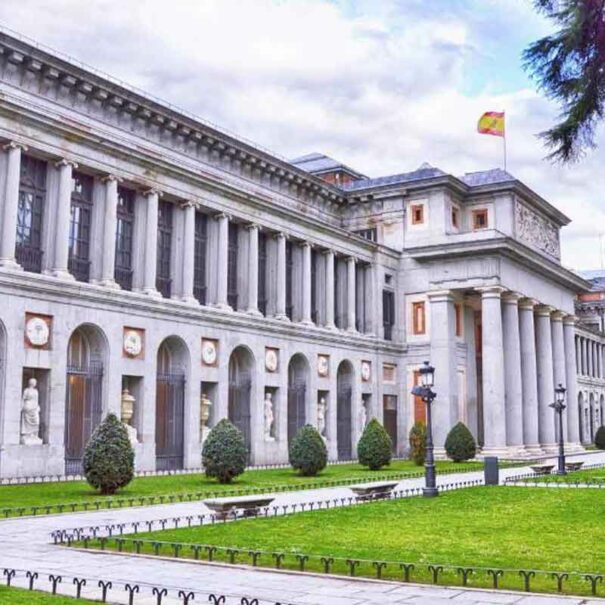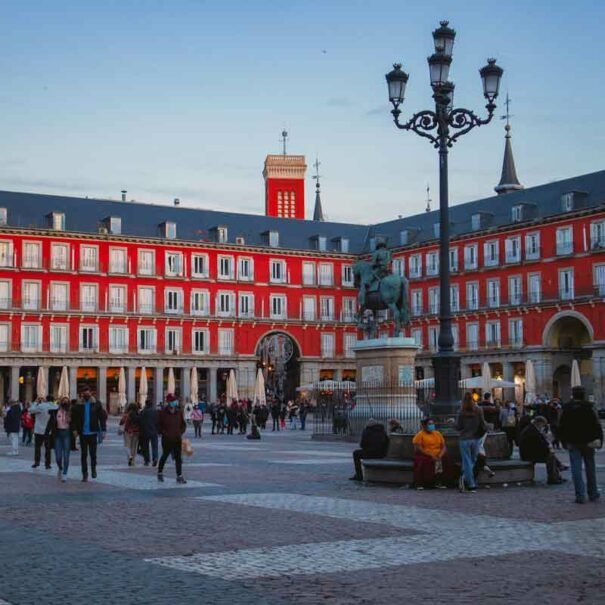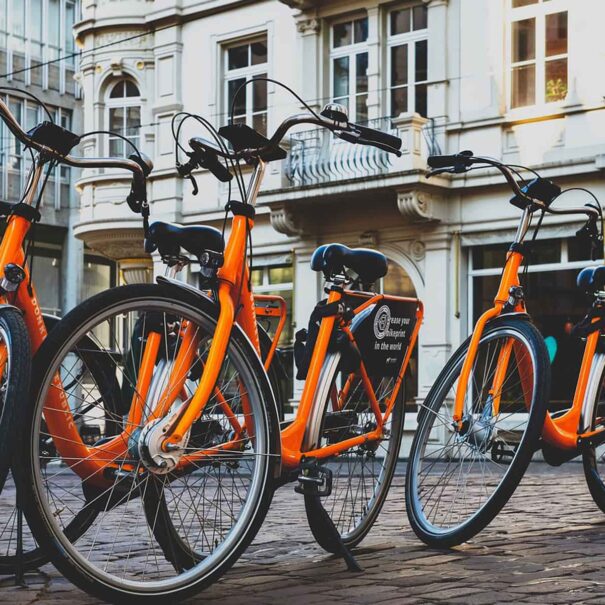Getting around Madrid by metro
Are you planning to visit or move to Madrid? In this article, you’ll find everything you need to know about getting around the Spanish capital by metro.

Nearest metro station to me in Madrid
Madrid metro timetable and map
Madrid’s metro network comprises twelve metro lines, three streetcar lines and one shuttle line, some of which are very busy, such as line 8.
Metro line timetables can be found on the EMT website, here.
Madrid Metro timetable
The Madrid metro runs every day from 6 a.m. to 1.30 a.m., with trains running at most every 15 minutes and at fastest every 2 minutes, depending on the line and the time of day you travel.
Expect to wait longer for the metro at weekends than on weekdays. If you have any doubts about the timetable, don’t hesitate to ask one of the Madrid metro staff present at certain stations, who will be able to inform you.
Madrid metro lines
The shuttle line (R) between Principe Pio and Opera is a very practical way of getting between the historic center and the Principe Pio shopping mall. If you’d like to visit the Campo del Moro, this line is also very practical and will save you a lot of walking.
Line 1 of the Madrid metro (light blue) crosses the capital from north to south, passing through Sol and Atocha, and terminating at Valdecarros and Pinar de Chamartin. This line is ideal for getting around the city’s historic center, and for getting to the Atocha train station from Puerta del Sol or Plaza Mayor.
Line 2 of the Madrid metro (red) also passes through Puerta del sol and is ideal for getting to the capital’s upmarket districts, as well as the Retiro Park from Puerta del sol, where it terminates at Las Rosas and Cuatro Caminos. It’s also the closest line to Madrid’s golden art triangle. If you want to visit the Prado Museum, this line will take you right up to its entrance. The nearest stop is “banco de Espana”.
Line 3 of the Madrid metro (yellow) also passes through Madrid city center via the sol and plaza de Espana stations. The termini are Villaverde and Moncloa. If you’re studying in Madrid, this line will be very useful for getting to Moncloa.
- Line 4 of the Madrid metro (brown) is mainly used to get around Madrid city center. Its termini are Argüelles and Pinar de Chamartin, located in the north of the city. This metro line passes through the Avenida America intercambiador, from where you can take buses out of Madrid.
- Line 5 of the Madrid metro (green) is one of the city’s longest lines, serving the northwest and east of Madrid, and passing through the Chueca, Gran Via and Casa de Campo districts. Often used by Madrid residents to get to Casa de Campo, this line is regularly crowded.
Madrid transport tourist map

Line 6 of the Madrid “circular” (gray) metro, as its name suggests, loops around Madrid city center, making it a great way to get around Madrid quickly, moving from line to line to reach your destination in record time. It has no terminus and passes through major stations such as Principe Pio, Moncloa and Pacifico.
Line 7 of the Madrid metro (orange) takes you to Atletico de Madrid’s stadium, the Metropolitano Wanda, which is very convenient on match days. This is one of the few metro lines not to enter Madrid city center.
Line 8 metro Madrid (pink), used extensively by locals and tourists alike, takes you from Madrid’s Adolfo Suárez airport to Madrid city center. You’ll be in downtown Madrid in less than 20 minutes, although you’ll probably have to change metro trains to get to your hotel. Line 8 also passes through IFEMA (Feria de Madrid stop).
Line 9 of the Madrid metro (purple) crosses the city from north to south; it doesn’t pass through downtown Madrid, but is used extensively by Madrid residents who work in the north of the city. This line terminates at Paco de Lucia and Puerta de Arganda, and passes through Plaza de Castilla. If you have an appointment or wish to visit the city’s business district, this is the line to take.
Line 10 of the Madrid metro (navy blue) is one of Madrid’s most popular lines. It serves office areas and the Santiago Bernabéu soccer stadium. This line is often saturated at peak times. We advise you to use it during off-peak hours to visit Madrid, as it passes through stations in the city center and offers you the opportunity to visit Madrid quickly. Its termini are Hospital Infanta Sofia and Tres Olivos.
Metro line 11 Madrid (dark green) is Madrid’s shortest metro line, with just 7 stations, and runs from Plaza Eliptica to La Fortuna, located in the south of Madrid, for a very quick trip to Plaza Eliptica.
Line 12 of Madrid’sMetroSur (mustard) is another circular line that loops around the south of Madrid, straddling the B1 and B2 zones, and will be very useful if you’re going to study at Juan Carlos University.
How much does a metro ticket cost in Madrid?
You can take the Madrid metro with different types of ticket with different characteristics.
Like most metros in the world, the cost of tickets depends on the journey, so zones have been determined. Here are the ticket prices according to zone:
- If you’re traveling in zones A, B, B1, B2 and B3, a ticket will cost you 3€ and is valid for a single journey. Ask for a “combined” ticket at the metro kiosk. The 10 “combined” trips will cost you 18,30€.
- If you’re traveling exclusively in zone A, a ticket will cost you 1,5€ and 12,20€ for 10 trips, and can be used for both metro and EMT bus services.
- If you are traveling exclusively in zone B1 or B2 or B3, a ticket will cost you 1,5€ and 12,20€ for 10 trips, and can be used for EMT metro and bus services.
- If you’re traveling from Madrid airport to the city center, it will cost you around 6,5€ if you’re departing from zone A, and up to 7,5€ from another zone.

Madrid's rechargeable metro passes
It is possible to travel around Madrid at lower fares, but to do so you’ll need a rechargeable season ticket. Here are the different cards available:
- The 30-day pass, which allows you to travel and use the metro network for 30 days from the date of first validation. Depending on your situation (young, senior or normal), you pay a different fare.
- Passes for large families and people with reduced mobility: as the name suggests, a number of criteria must be met in order to benefit from this pass and its advantages. Members of large families are eligible for a 20% discount.
We advise you to contact the Madrid metro services to obtain as much information as possible on the subject of passes.
If you’re coming to Madrid for a short stay, on vacation, for work or to meet friends, then you’ll be able to buy metro cards tailored to your needs:
- The multi card, which allows you to use public transport, can be topped up with as much as you like. The multi card can be purchased from automatic machines located at the city’s metro stations.
- The tourist card, ideal for a stay in Madrid, will enable you to get around the capital economically, using the city’s public transport system without travel limits. The tourist card is personal and non-transferable, and you may be asked to show proof of identity when using it.
Here are the rates for this card:
1,2,3,4,5 and 7-day passes are available, with rates ranging from €8.40 for 1 day in zone A to €35.40 for 7 days unlimited in zone A.
Children under 6 receive a 50% discount on the purchase of this card.
| Card | Duration | Price |
|---|---|---|
| Tourist Pass | 1 day | €8.40 |
| Tourist Pass | 2 days | €14.20 |
| Tourist Pass | 3 days | €18.40 |
| Tourist Pass | 5 days | €26.80 |
| Tourist Pass | 7 days | €35.40 |



